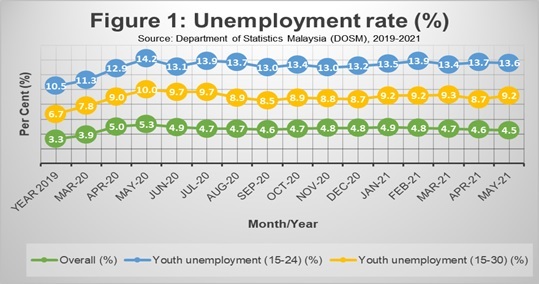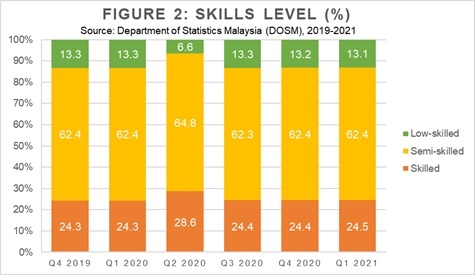
Published in Astro Awani & Business Today, image by Astro Awani.
With the daily five-digit Covid-19 infections for over three weeks and ongoing movement restrictions in the country, actual unemployment figures from June onwards can be expected to show an upward trajectory.
Such a phenomenon is reflected especially among Malaysians who earn a living through their low-skilled or semi-skilled jobs. As they require physical presence to perform their job, the movement restriction has constrained their ability to go out and earn daily wages to survive.
As a result, there were significantly more people especially in the Klang Valley coming to food banks for food or to seek shelter during the past few weeks. Citizens are also raising white flags to seek help due to the loss of jobs and income due to the movement restrictions.
Despite a decrease of 0.1% in the overall unemployment rate in Malaysia to 4.5% in May compared to 4.6% in April, the latest figure from the Department of Statistics Malaysia (DOSM) shows a total of 728,100 individuals remained unemployed in May. Out of this, 45.06% or 328,100 youths aged 15 to 24 are unemployed.
Such a figure is worrying as it is still relatively higher than the pre-pandemic level. As shown in Figure 1, the unemployment rate for those aged 15 to 24 registered an increase of 2.3 percentage points to a record 13.6%, as compared to the month where the Movement Control Order (MCO) was introduced in March 2020 (11.3%).

On the other hand, the unemployment rate for those aged 15 to 30 registered an increase of 1.4 percentage points to a record 9.2%, as compared to the month where the MCO was introduced in March 2020 (7.8%).
Although Skim Jaminan Penjanaan Pekerjaan (JanaKerja), MySTEP (Short-term Employment Programme), “Place and Train” initiatives, Reskilling and Upskilling Programmes and apprenticeship programme would provide opportunities for thousands of Malaysian youths to be hired or upgraded with relevant skillsets, the current youth unemployment rate for those aged 15 to 24 is three times higher than the overall unemployment rate in May.
Malaysian youths remain vulnerable
With more business closures and job losses due to the Covid-19 pandemic, Malaysian youths continuously remain one of the most vulnerable groups in securing a decent job with decent pay and benefits.
Since costs are additionally incurred in training new hires with no working experience, employers, in general, are not motivated to hire fresh graduates under the current climate.
A dire economic outlook also provides uncertainty among newly employed youths as they are often the first to be laid off (or face reduction in working hours) when the company downsizes.
Moreover, as Malaysia’s labour market comprises mostly of semi-skilled and low-skilled jobs, youth unemployment has been a prominent problem even before the emergence of the Covid-19 pandemic.
As shown in Figure 2, 62.4% of the labour market comprise those with semi-skilled jobs, while 13.3% are low-skilled jobs as of Q4 2019. The latest statistics for Q1 2021 reveal that composition of both semi-skilled and low-skilled jobs are similar to Q4 2019, whereby 62.4% are semi-skilled jobs while 13.1% are low-skilled jobs.

To cope with the continuous rise in living costs, some Malaysian youths have to accept low-paid and short-term jobs for the time being.
As they took any job available during the Covid-19 crisis, the median monthly salary for Malaysians with tertiary education (or whose higher level of education is above Form Five) went down from RM3,901 in 2019 to RM3,499 in 2020 – a decrease of 10.3% or RM402 – according to the latest DOSM’s Salaries & Wages Survey Report.
In contrast, the median monthly salary for Malaysians whose highest level of education was secondary education went down from RM1,955 (2019) to RM1,630 (2020) or a decrease of RM325 (16.6%), while median monthly salary for those with primary education went down from RM1,560 (2019) to RM1,274 (2020) or a decrease of RM286 (18.3%).
For Malaysians with no formal education, their median monthly salary as a whole dropped from RM1,436 (2019) to RM1,237 (2020), which represented a decline of RM199 (13.9%).
Underemployment and the risk of closing down
Although the overall unemployment rate hit a 14-month low compared to April 2020 (5%), the DOSM’s definition of employed persons involves those working just one hour a week and who may be unpaid workers in a family enterprise. Some of them may still be working at food stalls but found their income slashed.
Here is where the problem of underemployment comes in. It was already a big problem before the pandemic because Malaysia has a big informal economy where the official statistics may not capture those employed in these informal sectors – the mom-and-pop stalls out there for example.
While it was challenging to manage even the formal sector during the pandemic, the government has done relatively well in this sector because the peak of unemployment of 5.3% – the highest unemployment rate ever for Malaysia – was brought down to 4.5% in May this year through the various initiatives in our packages, reskilling, upskilling and wage subsidies.
But that was before the current total lockdown, and looking what is happening on the ground the number for June which will be announced shortly is expected to go up. So, the government will have to work harder to ensure that the actual unemployment figures for subsequent months after June onwards can be brought down.
With the ongoing dine-in ban in Peninsular Malaysia, F&B associations were pessimistic that up to 60% of food and beverage operators in the country would shut permanently within the next two months.
According to the Minister of Entrepreneur Development and Cooperatives (Medac) Datuk Seri Dr Wan Junaidi Tuanku Jaafar, up to 580,000 businesses – representing 49% of the micro, small and medium enterprise (MSME) sector – are at risk of closing down by October.
To compound the problem further, there is a growing number of Malaysian youths who fall under the “not in education, employment or training” (NEET) category (particularly in rural areas) that are not included in various measures to tackle youth unemployment.
The current curriculum emphasises less on matching training to available jobs, causing employers to be unsatisfied with the skillset of the graduates. While they do possess the technical know-how needed in the industry, their soft skills are comparatively weaker and may hinder their competency in day-to-day operations.
Many more young people will face difficulty transitioning from irregular and informal work to decent employment. And a growing number of NEET youths may become increasingly detached from the labour market.
Here are some suggestions for the government to consider:
- Stimulate new employment and entrepreneurship by focusing on the most vulnerable young people and getting them to work. Those young people who have lost their jobs should be supported through employment services, entrepreneurship schemes, and programmes that target their entry or re-entry into work. They could either be trained for waged job employment or becoming entrepreneurs. After the training, the government has to continue monitoring their progress for a minimum of six months to ensure its programmes have long lasting positive effects.
- Connect youth with valuable job-related resources. Partnering with the private sector at the local level is essential to identify the labour market demand, and help raise awareness and improve the attitudes of the private sector on setting up decent working conditions, while promoting youth employability. Keeping young people in the formal economy calls for initiatives that make them less likely to seek money-making opportunities through informal activities.
- Providing youth-targeted wage subsidy programmes.
- Supporting the young in employment planning and job search assistance.
- Providing standardised government credentials to all TVET institutions so that employers have a clear idea of the skills and accreditation possessed by their graduates, and preventing overlap in the given training.
- Developing programmes for youths in rural areas that are centred around job creation and skills training to support rural livelihoods and help those in the informal economy to shift to the formal economy.
The severe economic and labour market impact as a result of the pandemic on youth employability and employment requires urgent, large-scaled and targeted responses.
Jamari Mohtar and Amanda Yeo are part of the research team of EMIR Research, an independent think tank focused on strategic policy recommendations based on rigorous research.

